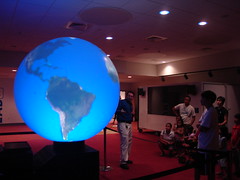 Indeed Exoplanetology is the Art and Science of Exoplanets. These photographs of bubbles provide stunning insights into visualizing and imagining how unseen exoplanets might look like. Consider the fact that planets especially Jovian planets like Jupiter, are "bubbles" themselves, albeit gargantuan in scale. The biosphere of the Earth is in fact, a bubble. And by the fractal laws of nature, the surface of bubbles provide a striking resemblance to the appearance of planets with a suitable atmosphere.
Indeed Exoplanetology is the Art and Science of Exoplanets. These photographs of bubbles provide stunning insights into visualizing and imagining how unseen exoplanets might look like. Consider the fact that planets especially Jovian planets like Jupiter, are "bubbles" themselves, albeit gargantuan in scale. The biosphere of the Earth is in fact, a bubble. And by the fractal laws of nature, the surface of bubbles provide a striking resemblance to the appearance of planets with a suitable atmosphere.
Thus soap bubbles, ephemeral as they may seem - can help in visualizing exoplanets since their surfaces follow the same laws of physics. And as how these photographs by Jason Tozer attests to, exoplanets - like soap bubbles - are also works of art.
One photograph bears a striking resemblance to Jupiter's patterns. I am speculating that if it were photographed in zero-gravity it would look a lot more like Jupiter.
The rest of these otherworldly photographs sets my mind careening into outer space, imagining how exoplanets would look like. To imagine and visualize them is what I can do for now, for to even see a glimpse of them is beyond our lifetime.








